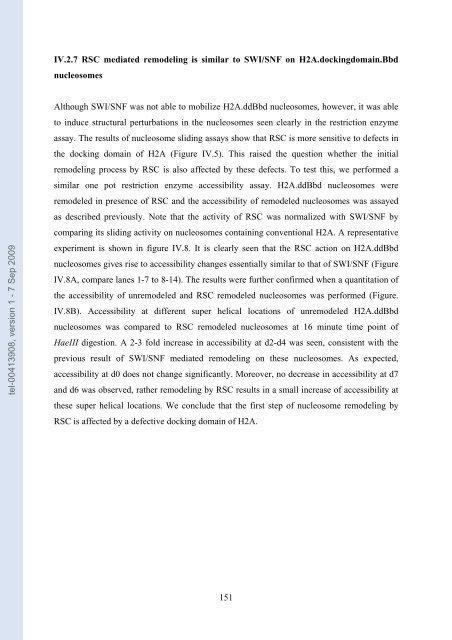Etudes sur le mécanisme de remodelage des nucléosomes par ...
Etudes sur le mécanisme de remodelage des nucléosomes par ...
Etudes sur le mécanisme de remodelage des nucléosomes par ...
You also want an ePaper? Increase the reach of your titles
YUMPU automatically turns print PDFs into web optimized ePapers that Google loves.
tel-00413908, version 1 - 7 Sep 2009<br />
IV.2.7 RSC mediated remo<strong>de</strong>ling is similar to SWI/SNF on H2A.dockingdomain.Bbd<br />
nuc<strong>le</strong>osomes<br />
Although SWI/SNF was not ab<strong>le</strong> to mobilize H2A.ddBbd nuc<strong>le</strong>osomes, however, it was ab<strong>le</strong><br />
to induce structural perturbations in the nuc<strong>le</strong>osomes seen c<strong>le</strong>arly in the restriction enzyme<br />
assay. The results of nuc<strong>le</strong>osome sliding assays show that RSC is more sensitive to <strong>de</strong>fects in<br />
the docking domain of H2A (Figure IV.5). This raised the question whether the initial<br />
remo<strong>de</strong>ling process by RSC is also affected by these <strong>de</strong>fects. To test this, we performed a<br />
similar one pot restriction enzyme accessibility assay. H2A.ddBbd nuc<strong>le</strong>osomes were<br />
remo<strong>de</strong><strong>le</strong>d in presence of RSC and the accessibility of remo<strong>de</strong><strong>le</strong>d nuc<strong>le</strong>osomes was assayed<br />
as <strong>de</strong>scribed previously. Note that the activity of RSC was normalized with SWI/SNF by<br />
com<strong>par</strong>ing its sliding activity on nuc<strong>le</strong>osomes containing conventional H2A. A representative<br />
experiment is shown in figure IV.8. It is c<strong>le</strong>arly seen that the RSC action on H2A.ddBbd<br />
nuc<strong>le</strong>osomes gives rise to accessibility changes essentially similar to that of SWI/SNF (Figure<br />
IV.8A, com<strong>par</strong>e lanes 1-7 to 8-14). The results were further confirmed when a quantitation of<br />
the accessibility of unremo<strong>de</strong><strong>le</strong>d and RSC remo<strong>de</strong><strong>le</strong>d nuc<strong>le</strong>osomes was performed (Figure.<br />
IV.8B). Accessibility at different super helical locations of unremo<strong>de</strong><strong>le</strong>d H2A.ddBbd<br />
nuc<strong>le</strong>osomes was com<strong>par</strong>ed to RSC remo<strong>de</strong><strong>le</strong>d nuc<strong>le</strong>osomes at 16 minute time point of<br />
HaeIII digestion. A 2-3 fold increase in accessibility at d2-d4 was seen, consistent with the<br />
previous result of SWI/SNF mediated remo<strong>de</strong>ling on these nuc<strong>le</strong>osomes. As expected,<br />
accessibility at d0 does not change significantly. Moreover, no <strong>de</strong>crease in accessibility at d7<br />
and d6 was observed, rather remo<strong>de</strong>ling by RSC results in a small increase of accessibility at<br />
these super helical locations. We conclu<strong>de</strong> that the first step of nuc<strong>le</strong>osome remo<strong>de</strong>ling by<br />
RSC is affected by a <strong>de</strong>fective docking domain of H2A.<br />
151

















